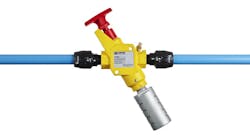Most manufacturing facilities use compressed air to power their production lines, but improper management of this unseen utility during routine maintenance and emergency situations can have serious consequences. Proper installation and use of a simple device like a pneumatic lockout valve (also known as a pneumatic isolation device) can prevent personal injury and death, but most facilities do not take the time to install such devices.
Pneumatic lockout valves carry such high importance that OSHA audits facilities for proper lockout/tagout procedures and devices. The OSHA standard that covers proper use of lockout valves is the Control of Hazardous Energy (lockout/tagout). This standard states that all machinery must have a proper device and procedure to neutralize the energy, thus shutting the machine off during routine maintenance and emergency situations.
In fiscal year 2019, OSHA wrote up enough lockout/tagout violations regarding improper control of hazardous energy that this specific violation it made it to #4 on its list of Top 10 frequently cited standards. These citations fall into either the Serious or Willful category. A serious violation (substantial probability of injury or death is present) carries a penalty of $13,653 and a willful violation (committed with intentional disregard for OSHA standards) carries a penalty of $136,532. For cost comparison purposes, the cost of a willful violation is approximately 45.5 times greater than the average cost of one pneumatic lockout valve.
How pneumatic lockout valves meet energy isolation device criteria
OSHA only enforces the use of an energy isolation device (i.e., lockout valve); however, the agency does not define what constitutes a lockout valve. The definition of a lockout valve is determined by ANSI B11.0 and PMMI B155.1. These standards list four criteria that a device needs to meet to be considered an energy isolation device:
- Capable of being locked in the OFF position only
- Easily identified as an isolation device
- Includes a visible pressure indicator
- Features an exhaust port equal to or larger than the supply ports
Now that we know the criteria, let’s take each one and analyze how pneumatic lockout valves meet the criteria for an energy isolation device.
1. Can they be locked in the OFF position only?
The purpose of a lockout valve is to quickly expel the pressurized compressed air in the lines and shut off the machine. This is done for maintenance and in emergency situations. When the handle of the lockout valve is pushed inward, it shuts off the flow of compressed air, and vents the downstream pressure out the exhaust port. Once the handle has been pushed in, a lock can be placed on the handle, preventing the handle from being pulled out and resuming the flow of compressed air to the machine prematurely. Unlike a ball valve that can be locked in both the open and closed positions, lockout valves can only be locked when the handle is pushed in, cutting off the flow of compressed air.
2. Can they be easily identified as an isolation device?
In the unfortunate event that an emergency shut-off is required, no one wants to be fumbling around trying to find what valve will shut off the flow of compressed air. To meet this criteria, most lockout valves are painted a bright yellow color and have a red handle (see Figure 1), making them easy to identify as a compressed air line shut-off.
3. Do they have a visible pressure indicator?
Energy isolation devices need to have some method of visibly showing if the device is under pressure or not. The type of indicator is not specified, so a lockout valve can use either an electronic meter or a simple manual pop-up indicator. On these indicators, a red button will be visible when the valve is under pressure, and the button will retract when the compressed air has been successfully vented from the valve.
4. Do they have an exhaust port equal to or larger than the supply ports?
Expelling compressed air from a line should be done as quickly as possible, which is why all energy isolation devices need to have a large exhaust port. In comparison, a vented ball valve has a tiny port – most of the time it is less than an inch. This small hole does not vent the air fast enough and could potentially concentrate the compressed air into a dangerous stream if the pressure gets high enough. This expelled air can create a loud whooshing sound. To quiet this action, some manufacturers offer various-sized silencers to match the exhaust port.
Considerations for an easy installation
Although safety is the primary purpose of pneumatic lockout valves, it’s helpful to also have devices that are easy to install. Some things to look for in this regard when specifying pneumatic lockout valves include:
- size and variety of threaded inlet ports
- threaded connectors, which can simplify connections between lockout valves and compressed air piping
- push-to-connect or snap ring ends to connect to aluminum pipe
- threaded end connectors that are available in several different configurations to allow the installation to be customized to the environment.
Pneumatic lockout valves offer the control over compressed air that manufacturing facilities need. Coupling these valves with a well-thought-out lockout/tagout procedure document will keep OSHA from citing your facility for improper control of hazardous energy and help keep your employees safe. Think of it as a wise investment in your company’s future and reputation.

